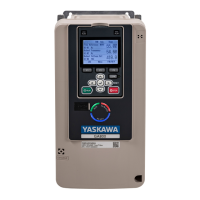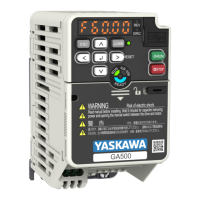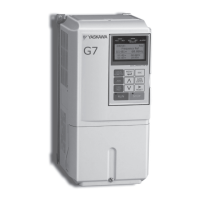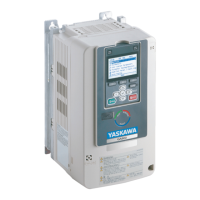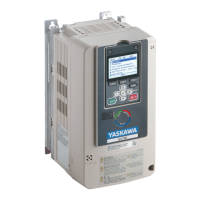Receiving
1
1.3 Features and Advantages of Control Methods
YASKAWA ELECTRIC SIEP C710617 05F YASKAWA AC Drive GA700 Technical Manual 27
Control Method
Selection
Open Loop V/f Control
(V/f)
Closed Loop V/f Control
(CL-V/f)
Notes
Controlled Motor Induction Motor -
Overexcitation
Deceleration
*1
Yes Yes
Sets the V/f higher than the setting value
during deceleration to increase motor loss
and decrease deceleration time.
Overvoltage
Suppression Function
*1 *2
Yes Yes
Adjusts speed during regeneration to
prevent overvoltage.
*1 Note these points when you use this function:
• When you can decouple the motor and machine for a test run, use Rotational Auto-Tuning. You must make adjustments to the
control in the range where there is no vibration in the machine after Rotational Auto-Tuning.
• Motor loss increases during overexcitation braking and high-slip braking. Use a maximum braking frequency of 5% ED and a
maximum braking time of 90 seconds. After you start high-slip braking, you cannot restart the motor until it stops. Use
overexcitation braking to decelerate over a shorter time at a pre-determined speed.
*2 Do not use this function with hoist application.
Table 1.6 OLV, CLV and AOLV Features and Advantages of Control Methods
Control
Method
Selection
Open Loop Vector
Control
(OLV)
Closed Loop Vector
Control
(CLV)
Advanced Open Loop
Vector Control
(AOLV)
Notes
Controlled
Motor
Induction Motor -
Parameter
Settings
A1-02 = 2
(Default)
A1-02 = 3 A1-02 = 4 -
Basic Control
Open Loop Current Vector
Control
Closed Loop Current
Vector Control
Open Loop Current Vector
Control
-
Main
Applications
• General-purpose
variable speed control
• Applications in which
high performance is
necessary without
machine encoders
Very high-performance
control with motor
encoders
Example: High-precision
speed control, torque
control, torque limits
Sensorless vector control
with speed control
• General-purpose
variable speed control
• Applications in which
high performance is
necessary without
machine encoders
-
PG Option Card Not necessary
Necessary (PG-B3 or PG-
X3)
Not necessary -
Maximum Output
Frequency
590 Hz 400 Hz 120 Hz -
Speed Control
Range
1:200 1:1500 1:200
This is the range of variable
control.
When you connect and operate
motors in this mode, think about
the increase in motor
temperature.
Starting Torque 200% / 0.3 Hz
*1
200% / 0 min
-1
*1
200% / 0.3 Hz
*1
This is the motor torque that the
drive can supply at low speed
during start-up and the related
output frequency (rotation
speed).
You must think about drive
capacity when a large quantity of
torque is necessary at low speed.
Auto-Tuning
*2
Rotational, Stationary, and
Line-to-Line Resistance
Rotational, Stationary, and
Line-to-Line Resistance
Rotational, Stationary, and
Line-to-Line Resistance
Automatically tunes electrical
motor parameters.
Torque Limits
*2
Yes Yes Yes
Controls maximum motor torque
to prevent damage to machines
and loads.
Torque Control
*2
No Yes
Yes (Although NOT low
speeds of approximately
10% or less)
Directly controls motor torque to
control tension and other
parameters.
Droop Control
*2
No Yes Yes
Sets load torque slip for motors.
Distributes motor loads.

